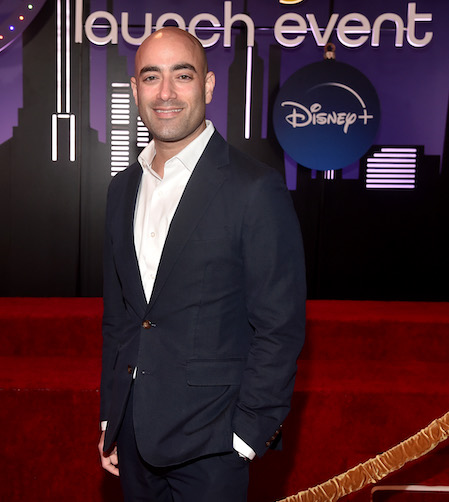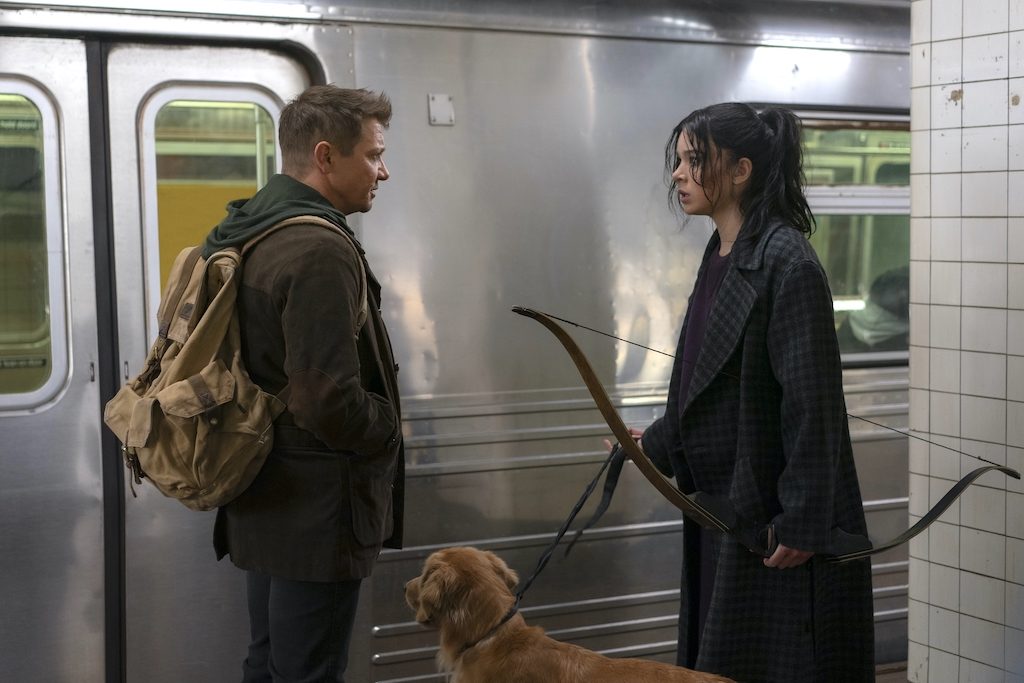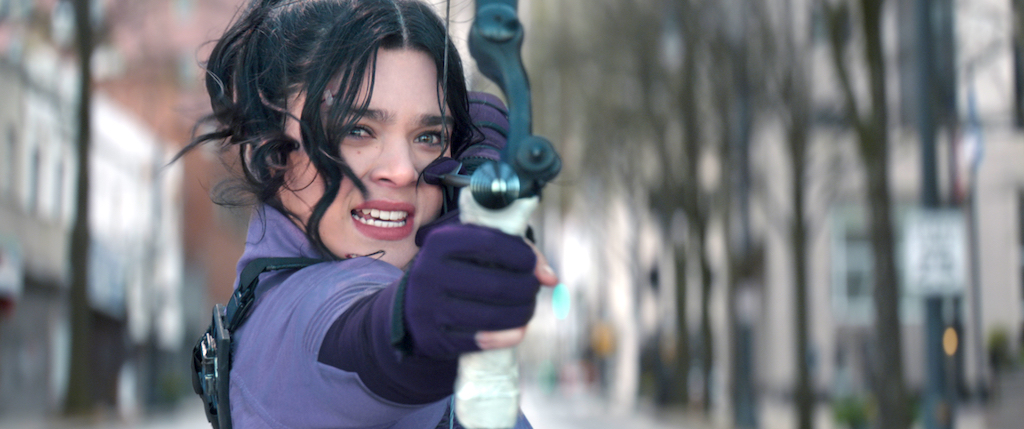Can an Avenger ever truly retire? No, but they can try. Hawkeye/ Clint Barton (Jeremy Renner) wanted to celebrate Christmas with his family until a former threat reappears to yank him out of retirement with his protégée. Reluctantly, he teams up with archer extraordinaire and Hawkeye’s (Clint Barton) biggest fan, Kate Bishop (Hailee Steinfield) to do what superheroes do. Despite the plethora of source material in the MCU universe, showrunner Jonathan Igla (Mad Men, Bridgerton) saw the opportunity to put his stamp on the material while honoring the original Hawkeye comic book series. He spoke with Creative Screenwriting Magazine about adapting this iconic post-blip Avengers story for television.
He started the process by re-reading the comics several times to determine where Clint Barton was physically and emotionally post Avengers: End Game. “I see Hawkeye as a marriage of two bodies of work. I’m picking up the thread of the ongoing MCU and marrying it to the vision of the artists who created the comic books,” declared Igla.
We asked him how his seemingly unrelated previous credits informed the series. “There was a real attention to detail in Mad Men that I carried with me into Hawkeye. We were always thinking about every character’s point of view in every scene [rather than just Clint’s or Kate’s]. Matt Weiner gave every single character a personality, even if they didn’t have a name or dialogue. It added so much dimension to it.”

Jonathan Igla. Photo by Alberto E. Rodriguez/ Getty Images for Disney)
From Avengers: End Game to Hawkeye
Rather than meticulously planning the entire series in the early drafts of Hawkeye, he zeroed in on the elements of the comic book that he loved. “At the end of the day, writing the screenplay was a combination of the broadest aspects of the comics and a bunch of tiny, specific things in them,” he continued.
Igla also sought to capture the comic tone of the Hawkeye comics which he found really funny. This tone, created by Stan Lee, is evident throughout most of the Marvel movies over the last decade or so. “It wasn’t about trying to ink that style, but rather connecting with it,” Igla elaborated.
The comedy was more than a tension release valve in the show. It highlighted Clint’s struggle with his emotions as he tried to grasp the Christmas cheer. “He’s not wallowing in his pain or self-pity. He’s trying to enjoy his holidays with his family.” This is a more realistic and humanistic way to tell a superhero story.
The carefully-timed comedic moments created space for real emotional connection between the characters and the characters and the audience. “I could borrow the best lines and the best jokes from the comics to bake into the show,” continued Igla. “It was also important that we didn’t force things into the show.”
Igla believes that was a key reason why Mad Men ran for seven seasons because creator Matt Weiner was very disciplined in only allowing things that fit into the show.
The dynamic between Clint and Kate was integral to the TV show. “If that’s working you know the show’s going to be OK,” said Igla. The first episode opened with Clint not understanding Kate’s infatuation with him although she was his apprentice.
After the foundation of tone and character was laid, Igla and his writing staff spent several months developing storylines for the six-episode limited series. “This led to potentially hundreds of pages of ideas that could make it to the show.”
Igla also had to view all the Avengers movies and Hawkeye’s circumstances as part of the development process. “They [Avenger’s movies] focused on Clint’s wife and children because he is clearly a family man.” This formed the basis of his identity so setting the series during Christmas made sense. Wanting to be with his family while he was reluctantly on duty was a key theme in the Avengers that was also explored in Hawkeye.
Hawkeye was also grieving the loss of of Natasha Romanoff (Scarlet Johansson) who sacrificed himself for him during End Game. Needless to say, he came into the TV series with a deep sense of loss and guilt weighing on him. “Having his family back hadn’t erased the trauma and the emotional heaviness, but informed his relationship with Kate.”
Clint and Kate
The conflicts between Clint and Kate were already built into the characters. Igla expanded on them. The decades-wide age gap was the first difference. “Kate belongs to an entirely difference generation.” They also came from contrasting backgrounds. Clint came from struggle while Kate came from wealth and privilege.
“There was also a fundamental contrast between Kate and Clint’s relationship to the idea that they are superheroes. This is one of the main avenues that each of them grows.” Clint was not just the reluctant hero. “He does not want to be a hero. It was something that he really struggled with… I think that what makes him a hero. He has a deep sense of knowing what is right.”
The burden of being a superhero influences Clint’s sense of duty. He doesn’t simply save the day and go home for the evening. “There is always a moment of hesitation of whether to act or not. He’s human. He’s flawed… The audience is aware of Clint’s attitude to being superhuman.”

Hawkeye/ Clint Barton (Jeremy Renner) & Kate Bishop (Hailee Steinfield) Courtesy of Marvel Studios 2021
On the other hand, Kate aspires to become a superhero(ine). It wasn’t thrust upon her. “I really wanted to explore this next generation of superheroes where they grew up with them saving their city.” This drives her desire to serve her community as her duty. The juxtaposition with Clint’s attitude forces them to explore each other’s point of view.
Kate is more than Clint’s protégée. Clint serves primarily as her mentor, but in many cases, he also acts as her parent or a sibling. “There is some sibling (or spousal) like bickering.”
Despite Clint being a reluctant teacher, he is very good at his job. Jonathan Igla’s parents and sister are teachers, so their motivations to educate their students and shape their lives filtered into Jonathan’s writing.
Hawkeye didn’t occupy much screen time in the Avengers movies, but it was significant. “There was a scene where Clint was teaching his daughter how to use a bow and arrow. So, teaching was in Clint’s DNA.”
Rather than overly focusing on the superhero element of Hawkeye, much of the series leaned into the buddy genre like two mismatched cops forced to work together until the mission is complete.
Other than duration, Jonathan Igla doesn’t see much difference in the storytelling between big and small screen Avengers movies. “I enjoy having time between each episode to enjoy and process them and anticipate and speculate about the next one.” Given that Marvel films are essentially franchises that utilize elements of television storytelling, except that audience must wait years for the next episode rather than a week. “They created anticipation for the next movies in the series by dropping breadcrumbs and red herrings.”
It’s always a challenge to tell a five hour story in a TV series rather than a two hour one as is the case in the films. “It comes down to how much story you want to tell in each chunk of time.”
Despite Jonathan Igla’s career success, he’s constantly learning. “I’ve learned from every job. I try to pick up a new technique or approach from everybody I work with.“
